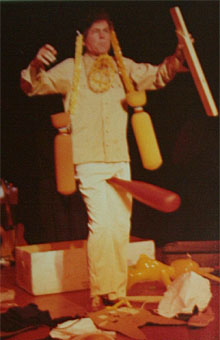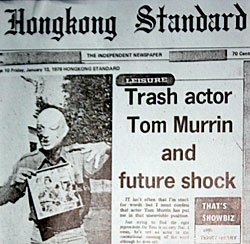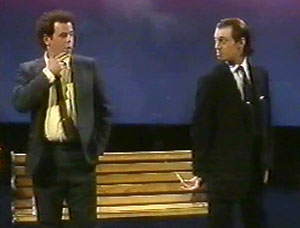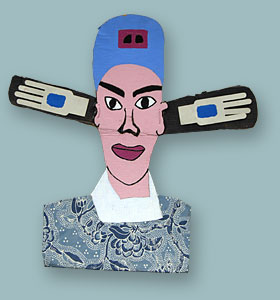
Tom Murrin was born in Hollywood and raised in Los Angeles, California, within walking distance of the La Brea Tar Pits. He graduated from Loyola High School, Loyola University and U.S.C. Law School. After practicing law, in association with Paul Caruso in Beverly Hills, he moved to New York City in the mid-60’s, where he received his Masters of Law from NYU, worked as an investigator for a company that insured the New York Medical Society for malpractice and began writing plays for off-off-Broadway theaters.
As a member of the “first generation” of La Mama playwrights (La Mama, E.T.C., founded by Ellen Stewart is still going strong, and recently celebrated its 45th anniversary), he had 4 plays done there: “Hung”, “Roommates”, and, produced by John Vacarro’s “Playhouse of the Ridiculous”, “Cock-Strong” and “Son of Cock-Strong”. Murrin also wrote songs for other Playhouse productions: Jackie Curtis’s “Heaven Grand in Amber Orbit” and Vacarro’s “Persaia; A Desert Cheapie”. “Myth (or Maybe Meth)”, a 2-act play, directed by Ed Setrakian, was done at the Andy Warhol Theater.

In the early ’70’s, Murrin lived in Paris, where “Cock-Strong” was staged at the University of Paris (as well as in Belgium and Amsterdam), and he began acting in plays at The American Center. In 1973, he moved to Seattle, Washington and, deciding to “learn how to become a performer by going out and doing shows”, Murrin was invited to join Para-Troupe, an experimental dance/theater group led by Alex “Soul Dancer” Schlissel. He and Johanna Went, a Seattle resident and novice actor, joined Para-Troupe at the same time, 1973-4.
With Para-Troupe members, Murrin created and performed “Balloon Theater”, which consisted of wearing Playhouse of the Ridiculous make-up (clown-like greasepaint with the addition of glitter), blowing up and making elaborate balloon sculptures, and then appearing at street fairs and other events, giving away the balloon sculptures. Shows were developed from workshop games and exercises and performed in artist’s lofts, parties, etc. Murrin postulated the idea of “Performance is anything done with purpose and style”, and the other members of Para-Troupe bought into this idea, allowing them to do whatever they felt best at doing, or wanted to try doing, or were willing to learn. Para-Troupe shows were a lot like “happenings”, with individual and group antics and theatrics, that invariably ended in a party.
In 1975, Murrin came up with the idea of “Dwarf Theater” (“theater that doesn’t get in your way”), and led 5 members of Para-Troupe down the West Coast , performing in colleges and universities in California cities, and then across the Southwest, through Arizona, New Mexico and Texas. In New Orleans, the other members of Para-Troupe returned to Seattle (with the VW station wagon), and Murrin and Went went on their way by bus and train, performing their two-person shows all that summer, almost daily, at schools, art galleries and outdoor events in Florida, Baltimore, New York City, Syracuse, and up into Canada, at Montreal, Ottawa and Toronto.
By now, Murrin and Went were doing what they called “Trash Theater”. They would set up anywhere, put on their make-up, blow up a few balloons and then do a completely different show every time, based on their theater games, improvising their dialogue, and using a multitude of found objects as props. Since they were using other people’s “trash” as their props, it was like giving those objects another brief “life”; afterwards the props would go back into the trash receptacles, and more things would be collected for the next day’s show. Murrin and Went were featured in an article in the prestigious Tulane Drama Review (the summer edition of either 1974 or 1975), an issue devoted to “alternative theater”.
In 1975, Craig Olander, another veteran of Para-Troupe in Seattle, joined Murrin and Went in Los Angeles, and the threesome began performing all over the city, at the Garden Theater Festival, April Fool’s Night at the Fox Theater in Venice, and the Roxy on Sunset Bioulevard. Murrin re-named the group “The World’s Greatest Theater Company”, and in 1976, they toured across the United States, performing in Las Vegas, Denver, Chicago, Washington, D.C. and New York City. Later that year, they traveled to Europe and did shows in London, Amsterdam and Frankfurt.

In the fall of 1977, Olander returned to Seattle, while Went remained in Los Angeles, and began her significant and ground-breaking solo career which took her into numerous punk rock clubs and performance venues over the next 2 decades. Murrin, who had always wanted to go around the world, flew to Japan on the day after Halloween, and began a tour of shows through major capitals in the Far East, including Tokyo, Hong Kong, Manila, Calcutta, New Delhi and Bombay. He did his 100th show in Bombay in April 1978. From there he continued on to Athens, Paris (where he performed a week of shows outside the recently completed Pompidou Centre), London and winding up at the Edinburgh Festival, Scotland.
He returned to NYC in the fall of 1978, and has been living and performing there ever since. His friend Bill Hart managed the edgy co-op art gallery, Razor, on West Broadway in Soho, and he allowed Murrin to use the basement of Razor to store his collected trash props, and to perform in front of the gallery on weekends. Living in Soho at that time was a godsend for Murrin, as the area was the center of New York’s art scene, as well as home to a lot of small manufacturers, and the weekly trash provided some wonderful things to work with.

After traveling around the world, finding, using and eventually discarding objects from many different cultures and societies, Murrin was of the opinion that any object could become a prop, as well as that almost anything could become a costume, or be worn on his head. Also at this time, Went sent Murrin 2 very significant gifts: an electric glue gun (which he immediately dubbed “the surrealist’s dream tool”) and about a dozen tubes of acrylic paint and some brushes. Her accompanying note said, “These will change your creative life.” And she was right. He began making and painting his own props and masks.
Murrin began performing under the name “Tom Trash”, continuing to do street shows, but also getting gigs in rock clubs, opening for the bands. The punk scene was just starting at that time in New York, and his brand of theater was considered “punk”. When traveling around the world, he referred to himself as a “theater performer”, and with his La Mama pedigree, he was accepted as a practitioner of “alternative theater”. The term “performance artist” wasn’t as popular then, although it was an “art world” term, often used to describe certain conceptual artists. A few years later, because of his doing more shows in art or performance venues, Murrin would be called a “performance artist”, but in the late ’70’s, he was more often called “that crazy guy who does these wild shows in between the bands.”
His friend Jane Friedman, who was Patti Smith’s original manager, and who also managed John Cale, began to include Murrin in most of Cale’s shows in New York, and on some tour dates in California. When Cale did his annual year-end week-long, two shows a night run at C.B.G.B.’s (culminating on New Year’s Eve), in ’78 & ’79, Murrin performed on the bill. He also worked at the other Lower East Side clubs, like the Pyramid, Club 57, a little further uptown at Max’s Kansas City, and a little further downtown at the Mudd Club.

When Murrin was scheduled to open for John Cale and his band at the Waldorf in San Francisco in 1979, Friedman was telling the club’s booker that his act was “funny”. He replied that “wouldn’t be a problem, because we often have comedians opening for bands here.” He asked what Murrin did, and she described his act, which at that time was a very fast-paced, quick-changing, chaotic making of a big mess on stage, complete with sight gags, visual puns, surreal masks and costumes, fake blood-letting, and general all-around loud and crazy anarchy. The San Franciscan club booker was quiet for awhile, and then he said to Friedman, “That sounds a little alien to us.” Friedman, who never really liked the name “Tom Trash” for Murrin’s act, said. “That’s it — why don’t you bill him as The Alien Comic.” And Murrin has performed under that name ever since.
During the early ’80’s in New York City, performance art was just starting to come into its own. Murrin first saw Stuart Sherman doing street shows, like himself, on West Broadway. He saw Paul Zaloom at the Kitchen, when it was in Soho. Murrin also did shows at the off-off Broadway theaters, like La Mama and Theater for the New City, where it was a real luxury to have a room to set up a show, and do it without having to get onstage in front of the audience, put down his drop cloth, set up his props, go off-stage and get into his many costumes (which he would invariably rip off throughout his show) and then go out and do a fast show in front a bunch of fans who really wanted to see the band they came to hear. Friedman at the time was the booker for Irving Plaza, which is still today one of the most popular venues for bands traveling through New York. And Murrin opened for many bands there, including X, Pere Ubu, the Stranglers, and James Brown (twice!).

In the early ’80’s Murrin met a group of women dancers who had recently graduated from Ohio University, in Athens, Ohio, who were then living in Manhattan. They were Jo Andres, Mimi Goese, Lucy Sexton and Annie Iobst, and they were interested in performing. Murrin taught Sexton and Iobst what he had learned along the way, and the two women became DANCENOISE. Andres developed a modern multi-media method of dance performance which included film, slides, layers of scrims, a light show, music and movement, and Goese’s early acts were very punk rock, intimidating and surprising, although she later performed as a singer in Hugo Largo, and other bands. The five became The Full Moon Crew, and with the production help of Bill Schaffner, they put on many Full Moon Shows at P.S. 122.

Murrin had been performing full moon shows since his days in Seattle, every full moon night, wherever he happened to be, he staged a comic ritual to Luna Macaroona, the moon goddess, thanking her for help and guidance during the past monthly cycle, and asking her for the same during the coming month. When he met the gals from Athens, 4 of them were living in a loft on 14th Street, and on a full moon night they woukd have a party, and he would do a show there, and so would everybody else. Schaffner thought it was a good enough idea to suggest it to Mark Russell at P.S. 122, and whenever the full moon fell on a dark night for the space, they would schedule a Full Moon Spectacular. The four would do their separate acts, and there would be 2 guest acts, like Ethyl Eichelberger, John Kelly, or Steve and Mark (Steve Buscemi and Mark Boone, Jr.). Murrin would do the opening number and introduce the rest of the show. Beer was served, the audience sat at tables and chairs in the middle of the room, and the shows became legendary. Murrin has produced many other full moon shows, at other venues around New York, and he continues to do his own full moon salutes to Luna Macaroona on the day/night of a full moon, to this day.
In the early and mid-’80’s, Murrin performed regularly at 8 B.C. (on East 8th Street, between Avenues B & C), which became one of the high spots of downtown entertainment during that time. The club was run by Cornelius Conboy and Dennis Gottra, and they succeeded in bringing together all sorts of artists and performers. At that time, the Lower East Side was the hot bed of the visual art scene, with new galleries opening weekly, and there was always new art on the 8 B.C. walls. Annie Golden debuted slides of her early work there. Each night there would be a performance or theater act, and a band, and it became a meeting spot for visual artists, performance artists and musicians. One night could have Popo and his gold-painted Butoh dancers, an Eric Bogosian monologue, followed by The Butt-Hole Surfers.
At another nearby club, Chandalier, run by Uzi Parnes and Ella Troyano , Murrin also performed often, one night he set up a Full Moon show with Karen Finley and Harry Kipper on the bill. King Tut’s Wah-Wah Hut, on Avenue A and E. 7th St., across from the Pyramid, was another popular place. DANCENOISE used to host a show there every Wednesday night for years. Alien Comic and Jo Andres were the first guest acts, and subsequently everybody that performed on the downtown scene did a night there; Annie and Lucy would prepare a special introduction for each act.
This was a “golden era” for performance in New York. Performance was truly “anything done with purpose and style”, and anybody who felt like doing it could. Franklin Furnace generously supported the fledging performance artists, and would give each one a good payday, as well as a week in residence, to set up a show. Darinka was another club that offered various performers and bands every night. A little later Ellie Kovan started Dixon Place, in her own apartment on East 2nd St., and had acts like Reno and JamesGodwin. Murrin averaged 50 shows a year, for over 20 years, and almost all of the shows were completely different. He would put together a show relative to the season, a forthcoming holiday, or current events. He received 2 New York Federation of the Arts grants: in 1984 and 1994.

Murrin often returned to Los Angeles during these years, to perform in some of Johanna Went’s spectacular shows, or also to do his own shows at L.A.C.E., the Anti-Club, Joe’s Bar, and in Theater Carnivale. He was the “Holiday Host” at La Mama for ten years, producing and performing in holiday shows, 4 times a year, introducing to La Mama audiences to many downtown acts, such as The Blue Man Group and The Five Lesbian Brothers, and individual performers such as Holly Hughes, Lisa Kron, Ethyl Eichelberger, and David and Amy Sedaris.
In 1993, Murrin toured the U.S. with Pere Ubu, Gun Club and Orangutang, traveling to twenty cities, from Atlanta to Vancouver, for Virago Recorrds.
In the mid-’90’, in the middle of an Alien Comic show at Dixon Place, there suddenly appeared the character of Jack Bump, who turned out to be Alien Comic’s “alter libido and evil twin”. Since that time, Jack Bump has been known to come out at other Alien Comic shows, sometimes completely uninvited, and his performances almost always seem to take a nasty turn. After a show that was to determine “who would remain, and who would leave”, Bump was forced to leave town (by the vote of the audience), only to return as a playwright, penning “bad taste sex comedies”. So, from 1999 to 2004, Bump had 5 plays done, all directed by David Soul, at various downtown venues. For the record, they were “Sport-Fuckers” (about middle-aged, Christian swingers), which had two separate productions at Theater for the New City; “Dick Play” and “Butt-Crack Bingo”, both done at La Mama; “Deviants Arise”, at Galapagos; and “Full Moon Super Bowl Tits”, at Little Theater at Tonic.
Murrin continues to perform, and teaches two-week workshops at La Mama, after which there is a night of performance in The Club at La Mama. Murrin’s opening remarks to his classes are: “First, get the gig, second, do the advertising, and then worry about the show.”
Murrin has also written for PAPER magazine for the past 16 years, covering the performance and stage scenes, writing about individual actors, dancers, playwrights and directors, and upcoming performance and theater works.

In November, 2006, Murrin/Alien Comic had a retrospective exhibition of his masks at Track 16 Gallery, Bergamont Station, Santa Monica, California, along with his friend, artist and co-performer Stephen Holman. Both men exhibited work, photos, flyers and videos, and gave 2 nights of live performance. In Spring, 2007, Murrin performed in Johanna Went’s shows at Track 16 gallery, in conjunction with her 5-week exhibition of costumes, photos and ephemera. And in the spring of 2008, 15 of Murrin’s masks and props were included in an outsider art show at Track 16, called Internal Systems Guidance, curated by Ann Grgich. Subsequently, in July, parts of that show and Murrin’s masks traveled to 2 galleries in Westhampton, Long Island, New York and Pennsylvania. Murrin has a scheduled one person show, called “Mostly Masks” at La Mama Galleria, on the Lower East Side, Manhattan, New York, for October, 2008.

In September, 2007, Murrin curated and moderated a panel on The Origins of Performance Art in the Lower east Side, for the Howl Festival, at the Bowery Poetry Club. The other participants were Martha Wilson, Brian Butterick, Rosalee Goldberg, David Leslie, Pat Oleszko, and Carlo McCormick.
In May, 2008, Murrin was honored by P.S. 122, along with his friend, producer/stage technician Lori E. Seid, at their annual Spring Gala and Benefit at Angel Orensanz Foundation. The successful event, which drew a few hundred people, was organized by Lucy Sexton, and included a grand art auction, a sit down dinner, and performances by the likes of The Blue Man Group, Mimi Goese, and Jonathan Ames. A portion of Murrin’s 1969 play, “Cock-Strong”, was read by actors David Cale, Steve Buscemi, Julie Atlas Muz and Justin Bond, with Lisa Kron reading the stage directions.
Johanna Went gave a humorous but heartfelt introductory speech, and presented a plaque to Murrin, which read,
Murrin performed into November of 2011, and did his last show at Dixon Place, at the age of 73. He was a tireless and generous supporter of younger artists, particularly when they doubted themselves. His writings about others in theater can be found in the PAPER Magazine. Murrin’s own archive of masks, props and costumes will be available for research in New York City, hopefully later this year at the NYU Fale’s Library.

